Pollen-Modified Flat Silk Cocoon Pressure Sensors for Wearable Applications
Abstract
:1. Introduction
2. Experimental Section
2.1. Materials
2.2. Preparation of PPy-Modified FSC (P-FSC)
2.3. Preparation of PPy/SFP-Modified FSC (P/SFP-FSC)
2.4. Preparation of P/SFP-FSC Pressure Sensors
2.5. Characterizations
3. Results and Discussion
3.1. Characterization of P/SFP-FSC Pressure Sensors
3.2. Analysis of Sensing Performance and Sensing Principle of Pressure Sensors
3.3. Micro-Pressure Detection Performance Analysis
3.4. Joint Movement Monitoring
3.5. Analysis of Results of Encrypted Message Transmission
4. Conclusions
Author Contributions
Funding
Institutional Review Board Statement
Informed Consent Statement
Data Availability Statement
Conflicts of Interest
References
- Wang, L.L.; Jackman, J.A.; Tan, E.L.; Park, J.H.; Potroz, M.G.; Hwang, E.T.; Cho, N.J. High-performance, flexible electronic skin sensor incorporating natural microcapsule actuators. Nano Energy 2017, 36, 38–45. [Google Scholar] [CrossRef]
- Wei, C.; Lin, W.S.; Liang, S.F.; Chen, M.J.; Zheng, Y.J.; Liao, X.Q.; Chen, Z. An all-in-one multifunctional touch sensor with carbon-based gradient resistance elements. Nano-Micro Lett. 2022, 14, 131. [Google Scholar] [CrossRef] [PubMed]
- Yang, L.; Wang, H.L.; Yuan, W.J.; Li, Y.H.; Gao, P.; Tiwari, N.; Chen, X.; Wang, Z.H.; Niu, G.Y.; Cheng, H.Y. Wearable pressure sensors based on mxene/tissue papers for wireless human health monitoring. ACS Appl. Mater. Interfaces 2021, 13, 60531–60543. [Google Scholar] [CrossRef] [PubMed]
- Hu, J.G.; Dun, G.H.; Geng, X.S.; Chen, J.; Wu, X.M.; Ren, T.L. Recent progress in flexible micro-pressure sensors for wearable health monitoring. Nanoscale Adv. 2023, 5, 3131–3145. [Google Scholar] [CrossRef]
- Fang, X.; Min, L.; Qin, Z.; Gong, S.; Zhao, B.; Lv, Y.; Pan, K. High-performance mxene-based flexible and wearable pressure sensor based on a micro-pyramid structured active layer. Adv. Mater. Technol. 2023, 8, 2200291. [Google Scholar] [CrossRef]
- Liu, T.; Gou, G.-Y.; Gao, F.; Yao, P.; Wu, H.; Guo, Y.; Yin, M.; Yang, J.; Wen, T.; Zhao, M.; et al. Multichannel flexible pulse perception array for intelligent disease diagnosis system. ACS Nano 2023, 17, 5673–5685. [Google Scholar] [CrossRef] [PubMed]
- Wang, S.; Zong, Q.; Yang, H.; Tan, C.; Huang, Q.; Liu, X.; Zhang, G.; French, P.; Ye, H. Rapid fabrication of high-performance flexible pressure sensors using laser pyrolysis direct writing. ACS Appl. Mater. Inter. 2023, 15, 41055–41066. [Google Scholar] [CrossRef]
- Wang, Y.; Duan, S.S.; Liu, J.C.; Zhao, F.Z.; Chen, P.Z.; Shi, Q.F.; Wu, J. Highly-sensitive expandable microsphere-based flexible pressure sensor for human-machine interaction. J. Micromech. Microeng. 2023, 33, 115009. [Google Scholar] [CrossRef]
- Xu, M.; Cai, H.; Liu, Z.; Chen, F.; Wang, Y.; Dai, F.; Li, Z. Skin-friendly corrugated multilayer microspherical sensor fabricated with silk fibroin, poly (lactic-co-glycolic acid), polyaniline, and kappa-carrageenan for wide range pressure detection. Int. J. Biol. Macromol. 2022, 194, 755–762. [Google Scholar] [CrossRef]
- Yang, T.; Deng, W.L.; Chu, X.; Wang, X.; Hu, Y.T.; Fan, X.; Song, J.; Gao, Y.Y.; Zhang, B.B.; Tian, G.; et al. Hierarchically microstructure-bioinspired flexible piezoresistive bioelectronics. ACS Nano 2021, 15, 11555–11563. [Google Scholar] [CrossRef]
- Zhao, X.-F.; Hang, C.-Z.; Lu, H.-L.; Xu, K.; Zhang, H.; Yang, F.; Ma, R.-G.; Wang, J.-C.; Zhang, D.W. A skin-like sensor for intelligent Braille recognition. Nano Energy 2020, 68, 104346. [Google Scholar] [CrossRef]
- Li, W.; Jin, X.; Han, X.; Li, Y.; Wang, W.; Lin, T.; Zhu, Z. Synergy of porous structure and microstructure in piezoresistive material for high-performance and flexible pressure sensors. ACS Appl. Mater. Interfaces 2021, 13, 19211–19220. [Google Scholar] [CrossRef] [PubMed]
- Park, B.; Jung, Y.; Ko, J.S.; Park, J.; Cho, H. Self-restoring capacitive pressure sensor based on three-dimensional porous structure and shape memory polymer. Polymers 2021, 13, 824. [Google Scholar] [CrossRef] [PubMed]
- Zheng, X.; Zhang, S.; Zhou, M.; Lu, H.; Guo, S.; Zhang, Y.; Li, C.; Tan, S.C. Mxene functionalized, highly breathable and sensitive pressure sensors with multi-layered porous structure. Adv. Funct. Mater. 2023, 33, 2214880. [Google Scholar] [CrossRef]
- Zheng, Y.; Yin, R.; Zhao, Y.; Liu, H.; Zhang, D.; Shi, X.; Zhang, B.; Liu, C.; Shen, C. Conductive MXene/cotton fabric based pressure sensor with both high sensitivity and wide sensing range for human motion detection and E-skin. Chem. Eng. J. 2021, 420, 127720. [Google Scholar] [CrossRef]
- Lee, D.; Lee, H.; Jeong, Y.; Ahn, Y.; Nam, G.; Lee, Y. Highly sensitive, transparent, and durable pressure sensors based on sea-urchin shaped metal nanoparticles. Adv. Mater. 2016, 28, 9364–9369. [Google Scholar] [CrossRef] [PubMed]
- Mundargi, R.C.; Potroz, M.G.; Park, J.H.; Seo, J.; Lee, J.H.; Cho, N.-J. Extraction of sporopollenin exine capsules from sunflower pollen grains. Rsc. Adv. 2016, 6, 16533–16539. [Google Scholar] [CrossRef]
- Shi, L.; Li, Z.; Chen, M.; Qin, Y.; Jiang, Y.; Wu, L. Quantum effect-based flexible and transparent pressure sensors with ultrahigh sensitivity and sensing density. Nat. Commun. 2020, 11, 3529. [Google Scholar] [CrossRef]
- Wang, K.; Lou, Z.; Wang, L.; Zhao, L.; Zhao, S.; Wang, D.; Han, W.; Jiang, K.; Shen, G. Bioinspired interlocked structure-induced high deformability for two-dimensional titanium carbide (MXene)/natural microcapsule-based flexible pressure sensors. ACS Nano 2019, 13, 9139–9147. [Google Scholar] [CrossRef]
- Wang, X.-M.; Tao, L.-Q.; Yuan, M.; Wang, Z.-P.; Yu, J.; Xie, D.; Luo, F.; Chen, X.; Wong, C. Sea urchin-like microstructure pressure sensors with an ultra-broad range and high sensitivity. Nat. Commun. 2021, 12, 1776. [Google Scholar] [CrossRef]
- Feng, X.; Ran, Y.; Li, X.; Xu, H.; Huang, Q.; Duan, Z. Amorphous carbon derived from daily carbon ink for wide detection range, low-cost, eco-friendly and flexible pressure sensor. Mater. Chem. Phys. 2024, 321, 129489. [Google Scholar] [CrossRef]
- Lu, L.; Zhao, Y.; Lin, N.; Xie, Y. Skin-inspired flexible pressure sensor with hierarchical interlocked spinosum microstructure by laser direct writing for high sensitivity and large linearity. Sens. Actuators A Phys. 2024, 366, 114988. [Google Scholar] [CrossRef]
- Dong, X.; Liu, Q.; Liu, S.; Wu, R.; Ma, L. Silk fibroin based conductive film for multifunctional sensing and energy harvesting. Adv. Fiber Mater. 2022, 4, 885–893. [Google Scholar] [CrossRef]
- Li, K.; Yang, W.; Shen, Z.; Zhang, X.; Zhu, Y.; Wang, Y.; Yi, M. A flexible graphene pressure sensor with high sensitivity based on sewn multi-layer anti-slip cloth. Sens. Actuators A Phys. 2024, 365, 114913. [Google Scholar] [CrossRef]
- Liu, M.-Y.; Hang, C.-Z.; Zhao, X.-F.; Zhu, L.-Y.; Ma, R.-G.; Wang, J.-C.; Lu, H.-L.; Zhang, D.W. Advance on flexible pressure sensors based on metal and carbonaceous nanomaterial. Nano Energy 2021, 87, 106181. [Google Scholar] [CrossRef]
- Yin, F.; Guo, Y.; Li, H.; Yue, W.; Zhang, C.; Chen, D.; Geng, W.; Li, Y.; Gao, S.; Shen, G. A waterproof and breathable cotton/rGO/CNT composite for constructing a layer-by-layer structured multifunctional flexible sensor. Nano Res. 2022, 15, 9341–9351. [Google Scholar] [CrossRef]
- Zhang, X.; Li, J.; Lin, J.; Li, W.; Chu, W.; Zhang, M.; Lu, Y.; He, X.; Zhao, Q. Highly stretchable electronic-skin sensors with porous microstructure for efficient multimodal sensing with wearable comfort. Adv. Mater. Interfaces 2023, 10, 2201958. [Google Scholar] [CrossRef]
- Cheng, Y.; Ma, Y.; Li, L.; Zhu, M.; Yue, Y.; Liu, W.; Wang, L.; Jia, S.; Li, C.; Qi, T.; et al. Bioinspired microspines for a high-performance spray Ti3C2Tx MXene-based piezoresistive sensor. ACS Nano 2020, 14, 2145–2155. [Google Scholar] [CrossRef] [PubMed]
- Li, L.; Cheng, Y.; Cao, H.; Liang, Z.; Liu, Z.; Yan, S.; Li, L.; Jia, S.; Wang, J.; Gao, Y. MXene/rGO/PS spheres multiple physical networks as high-performance pressure sensor. Nano Energy 2022, 95, 106986. [Google Scholar] [CrossRef]
- Yu, Q.; Su, C.; Bi, S.; Huang, Y.; Li, J.; Shao, H.; Jiang, J.; Chen, N. Ti3C2Tx@nonwoven fabric composite: Promising MXene-coated fabric for wearable piezoresistive pressure sensors. ACS Appl. Mater. Interfaces 2022, 14, 9632–9643. [Google Scholar] [CrossRef]
- Li, Y.; Wang, R.; Wang, G.-E.; Feng, S.; Shi, W.; Cheng, Y.; Shi, L.; Fu, K.; Sun, J. Mutually noninterfering flexible pressure–temperature dual-modal sensors based on conductive metal–organic framework for electronic skin. ACS Nano 2022, 16, 473–484. [Google Scholar] [CrossRef] [PubMed]
- Wen, D.-L.; Huang, P.; Li, B.-Y.; Qiu, Y.; Wang, Y.-L.; Zhang, X.-R.; Deng, H.-T.; Zhang, X.-S. Silk fibroin/Ag nanowire-based multifunctional sensor for wearable self-powered wireless multi-sensing microsystems. Nano Energy 2023, 113, 108569. [Google Scholar] [CrossRef]
- Raman, S.; Ravi Sankar, A. Intrinsically conducting polymers in flexible and stretchable resistive strain sensors: A review. J. Mater. Sci. 2022, 57, 13152–13178. [Google Scholar] [CrossRef]
- Xu, M.; Wang, Y.; Chen, F.; Wang, J.; Dai, F.; Li, Z. Breathable nanomesh pressure sensor with layered polyaniline grown at gas-liquid interface. Chem. Eng. J. 2022, 445, 136717. [Google Scholar] [CrossRef]
- Zhao, Y.; Li, C.; Lang, T.; Gao, J.; Zhang, H.; Zhao, Y.; Guo, Z.; Miao, Z. Research progress on intrinsically conductive polymers and conductive polymer-based composites for electromagnetic shielding. Molecules 2023, 28, 7647. [Google Scholar] [CrossRef] [PubMed]
- Veeralingam, S.; Praveen, S.; Vemula, M.; Badhulika, S. One-step synthesis of carbon-doped ppy nanoparticles interspersed in 3d porous melamine foam as a high-performance piezoresistive pressure, strain, and breath sensor. Mater. Chem. Front. 2022, 6, 570–579. [Google Scholar] [CrossRef]
- Gunasekara, D.S.W.; Niu, X.; Lqbal, W.; He, Y.; Liu, H. Pyrrole coating with in situ polymerization for piezoresistive sensor development—A review. Macromol. Res. 2022, 30, 153–162. [Google Scholar] [CrossRef]
- Xia, H.; Wang, L.; Zhang, H.; Wang, Z.; Zhu, L.; Cai, H.; Ma, Y.; Yang, Z.; Zhang, D. MXene/PPy@PDMS sponge-based flexible pressure sensor for human posture recognition with the assistance of a convolutional neural network in deep learning. Microsyst. Nanoeng. 2023, 9, 155. [Google Scholar] [CrossRef] [PubMed]
- Wang, Y.J.; Wang, Y.; Xu, M.T.; Dai, F.Y.; Li, Z. Flat silk cocoon pressure sensor based on a sea urchin-like microstructure for intelligent sensing. ACS Sustain. Chem. Eng. 2022, 10, 17252–17260. [Google Scholar] [CrossRef]
- Li, J.; Hou, Y.-X.; Wang, Y.-Y.; Ye, F.; Zhong, G.-Y. The piezoresistance of a device with polyphenylenevinylene derivative pss-ppv film. Microsyst. Technol. 2019, 25, 423–430. [Google Scholar] [CrossRef]
- Li, R.; Panahi-Sarmad, M.; Chen, T.; Wang, A.; Xu, R.; Xiao, X. Highly sensitive and flexible capacitive pressure sensor based on a dual-structured nanofiber membrane as the dielectric for attachable wearable electronics. ACS Appl. Electron. Mater. 2022, 4, 469–477. [Google Scholar] [CrossRef]
- Nikbakhtnasrabadi, F.; Hosseini, E.S.; Dervin, S.; Shakthivel, D. Smart bandage with inductor-capacitor resonant tank based printed wireless pressure sensor on electrospun poly-L-lactide nanofibers. Adv. Electron. Mater. 2022, 8, 2101348. [Google Scholar] [CrossRef]
- Raza, T.; Tufail, M.K.; Ali, A.; Boakye, A.; Qi, X.; Ma, Y.; Ali, A. Wearable and flexible multifunctional sensor based on laser-induced graphene for the sports monitoring system. ACS Appl. Mater. Interfaces 2022, 14, 54170–54181. [Google Scholar] [CrossRef] [PubMed]
- Su, Z.; Xu, D.; Liu, Y.; Gao, C.; Ge, C.; Chen, Z.; Liu, K. All-Fabric Tactile Sensors Based on Sandwich Structure Design with Tunable Responsiveness. ACS Appl. Mater. Interfaces 2023, 15, 32002–32010. [Google Scholar] [CrossRef] [PubMed]
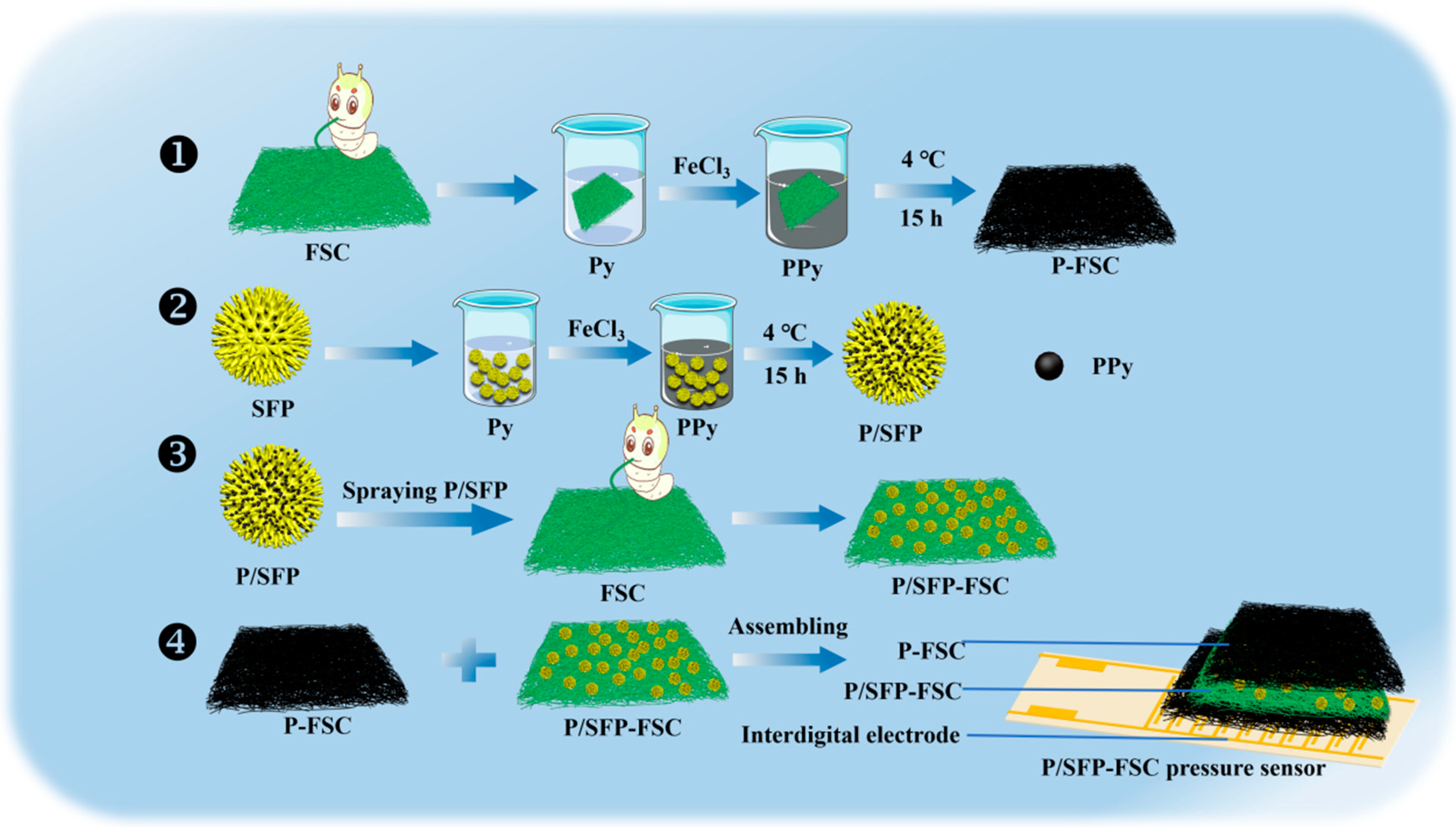

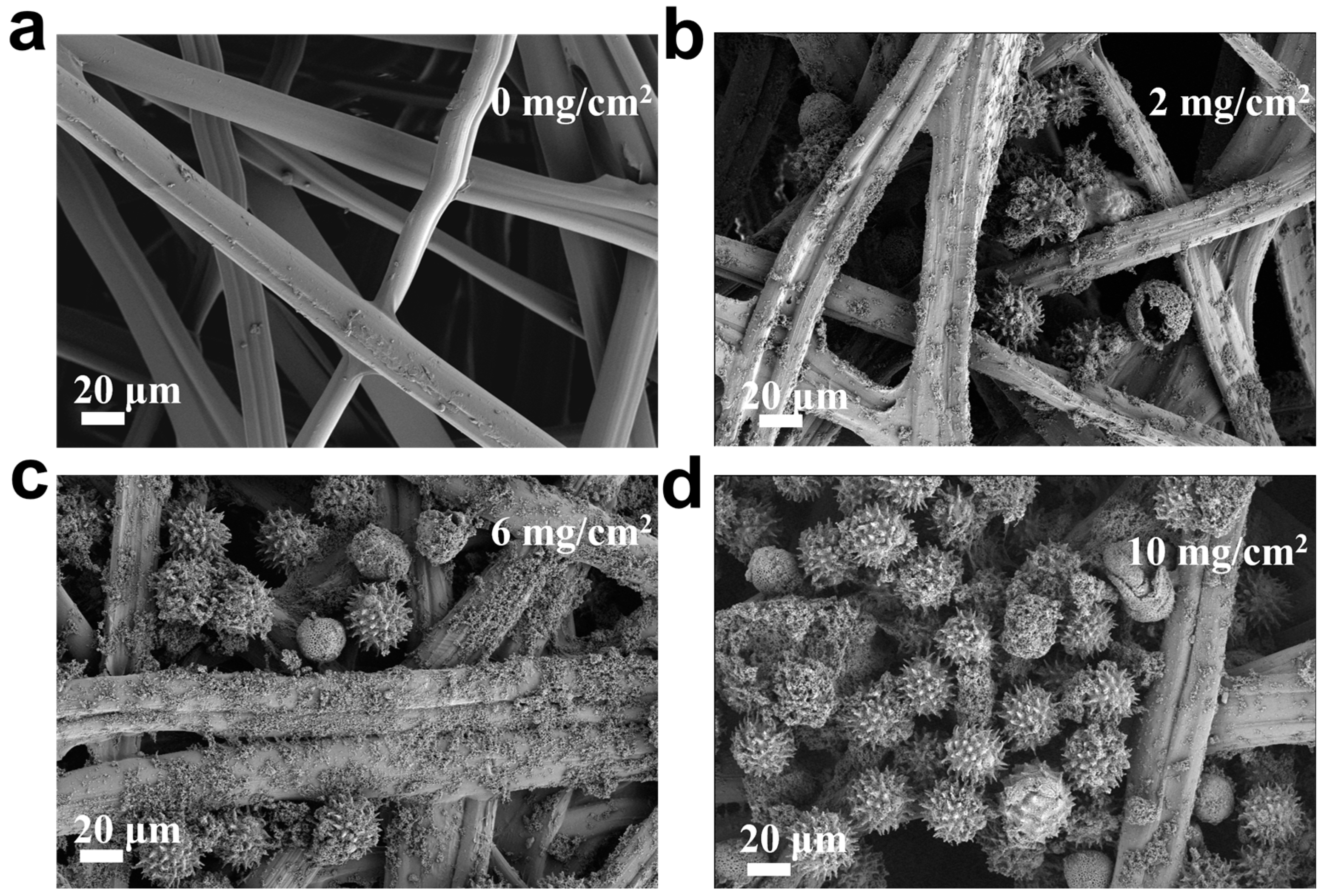
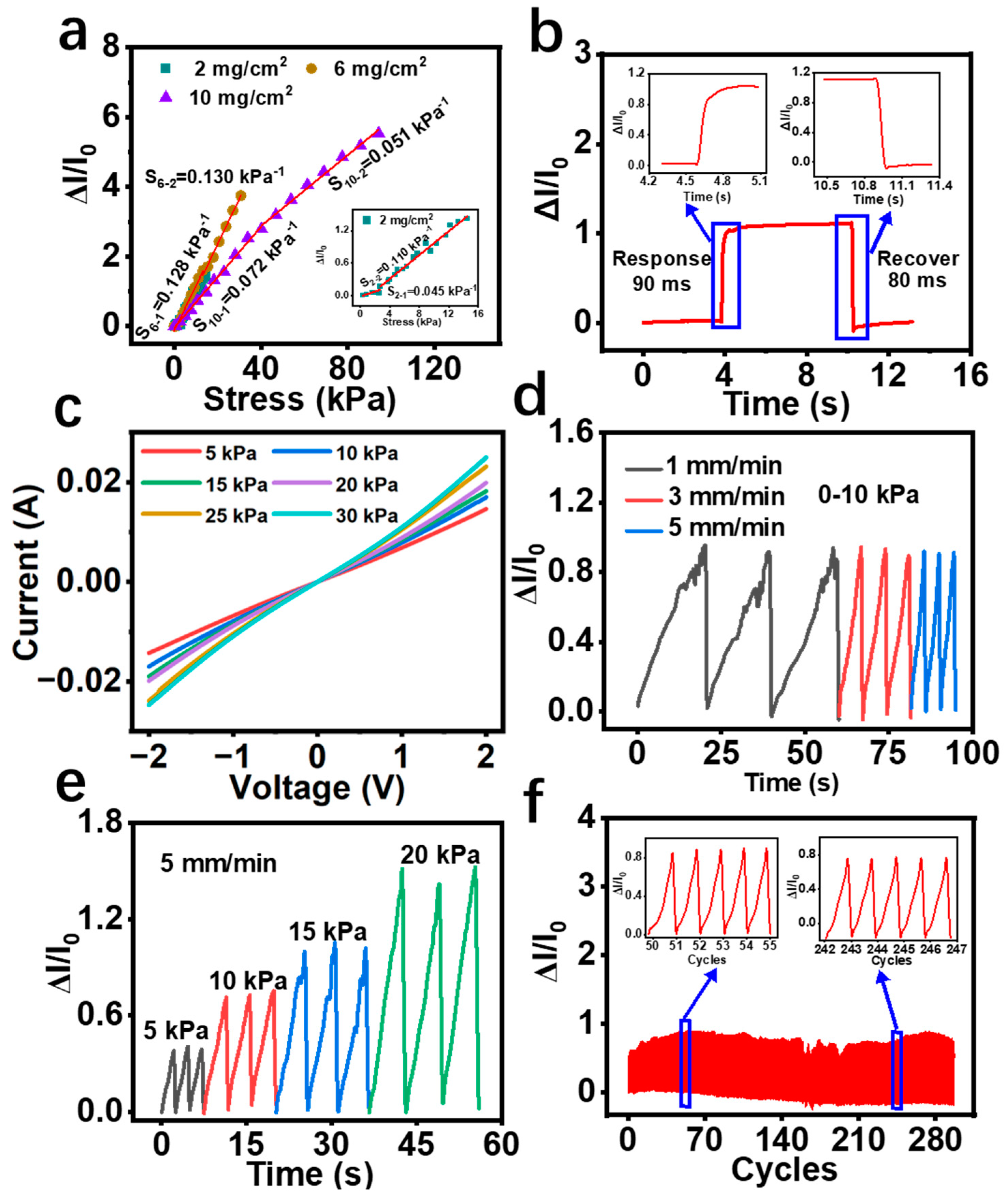

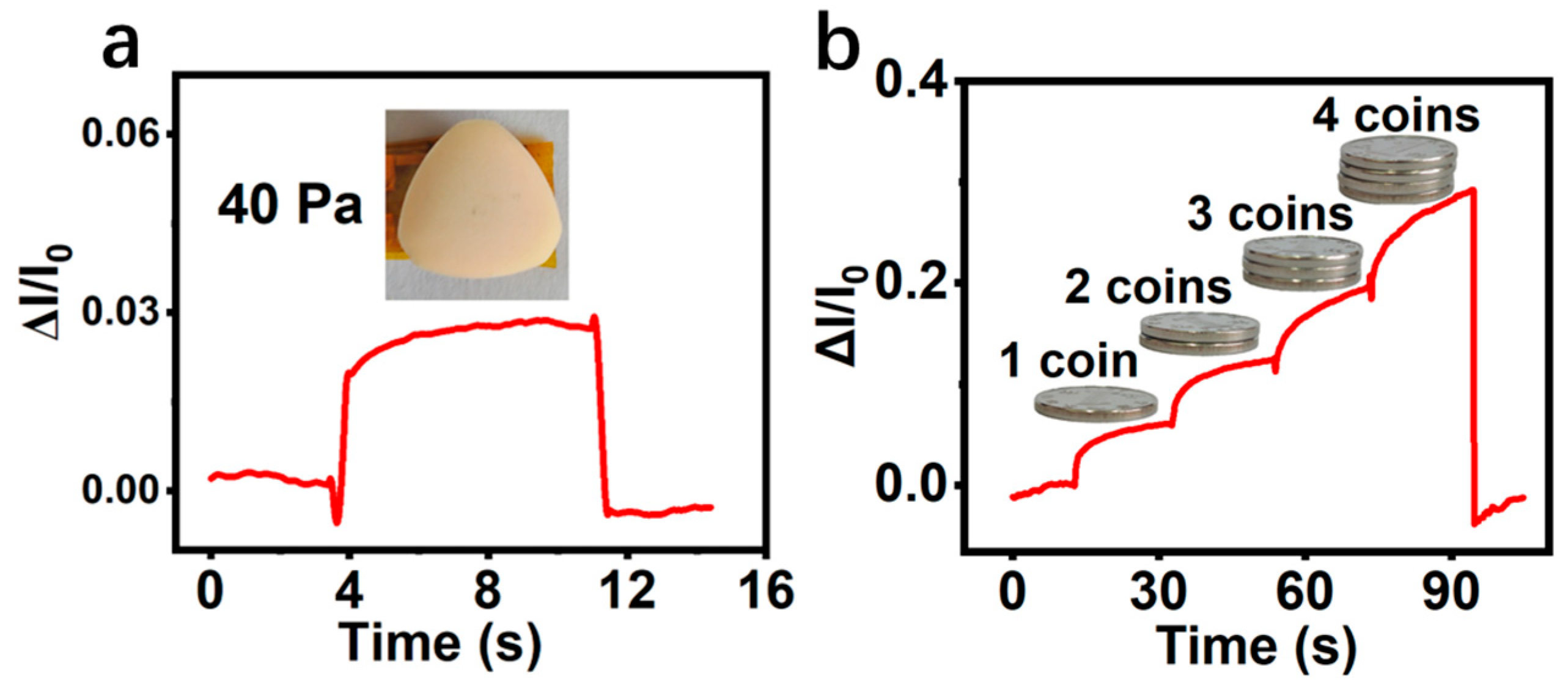
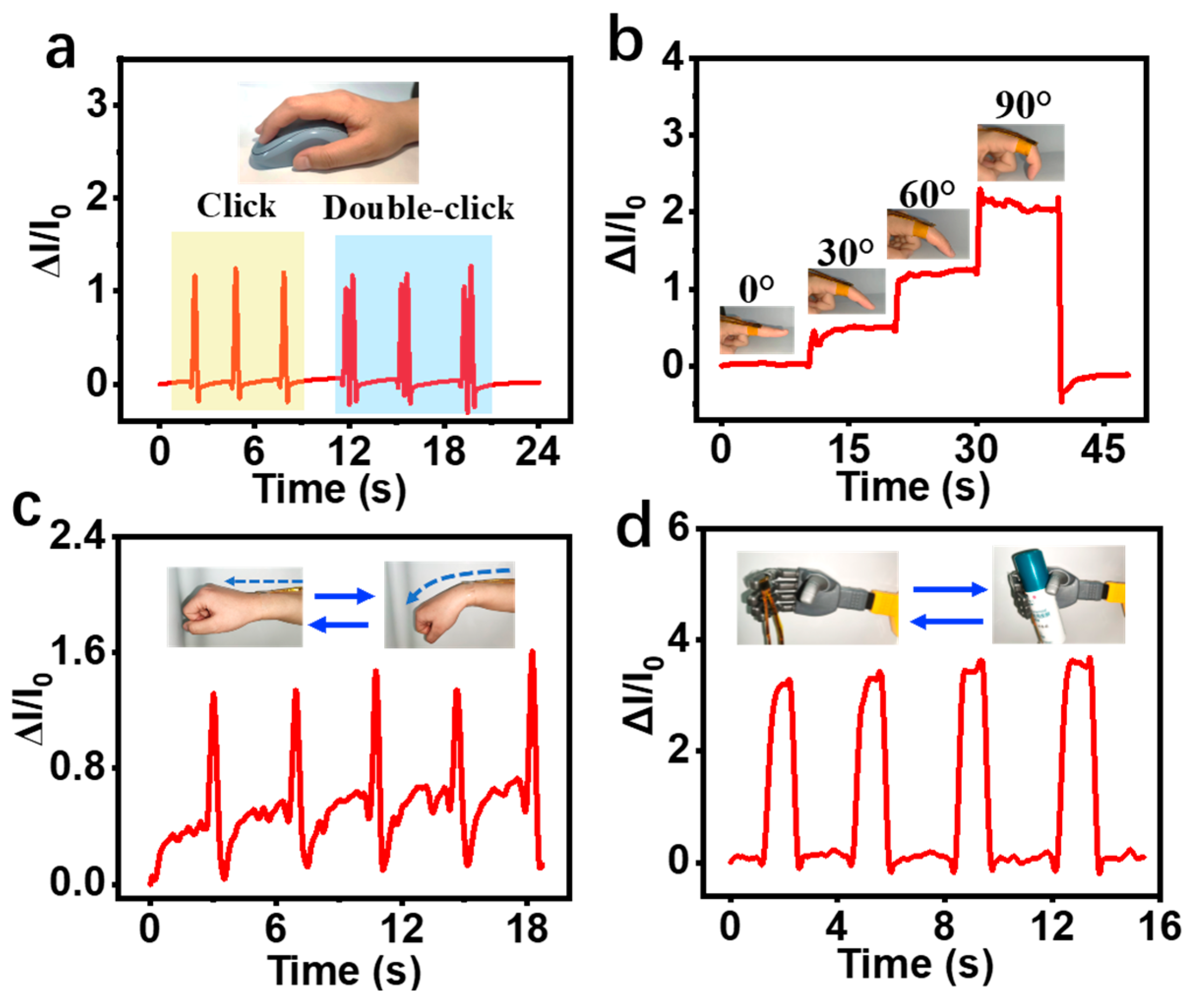
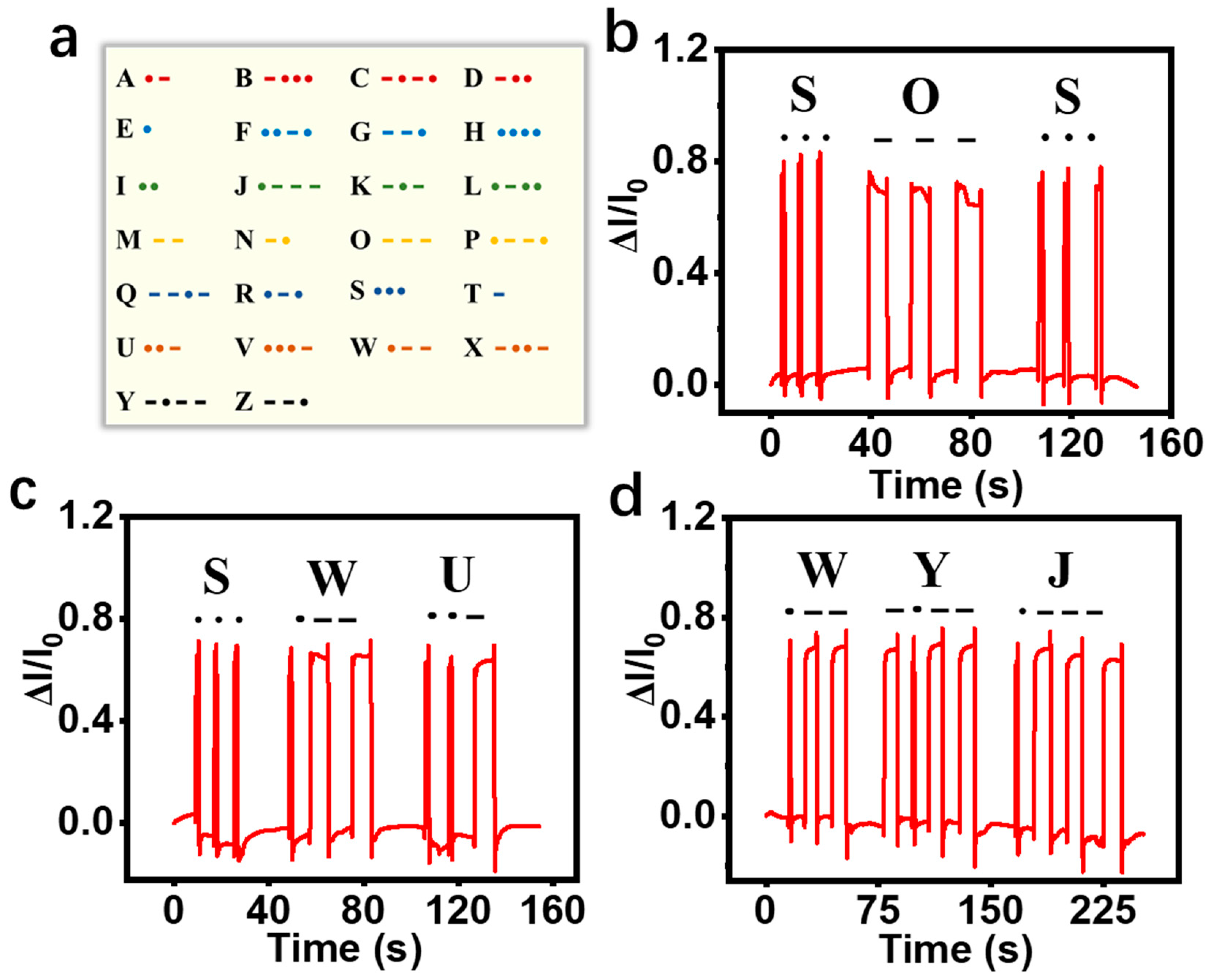
| Samples | Stress Range/kPa | Sensitivity/kPa−1 |
|---|---|---|
| 2 mg/cm2 | 0–2.72 | 0.045 |
| 2.72–14.5 | 0.11 | |
| 6 mg/cm2 | 0–13.18 | 0.128 |
| 13.18–30.65 | 0.13 | |
| 10 mg/cm2 | 0–40.14 | 0.072 |
| 40.14–94.19 | 0.051 |
| Reference | Substrate Structure | Conductive Material | Sensitivity (kPa−1) | Response Time (ms) | Sensing Range (kPa) |
|---|---|---|---|---|---|
| [9] | SF/PLGA fibers | SiO2/PANI | 0.071 | 145 | 0.01−380 |
| [38] | flat silk cocoon | MXene | 0.005 | 140 | 0–82 |
| [40] | PLLA substrates | sliver paste | 0.035 | - | 0–12 |
| [41] | cotton fabric | LIG | 0.0085/0.0012 | 70 | 0–30/30–220 |
| [42] | silk fiber film | AgNWs | 0.075/0.0084 | - | 0–10/10–53 |
| [43] | nylon fabric | Ag | 0.036 | 104 | 0.2–5 |
| this work | flat silk cocoon | PPy/SFP | 0.13 | 90 | 0–30.65 |
Disclaimer/Publisher’s Note: The statements, opinions and data contained in all publications are solely those of the individual author(s) and contributor(s) and not of MDPI and/or the editor(s). MDPI and/or the editor(s) disclaim responsibility for any injury to people or property resulting from any ideas, methods, instructions or products referred to in the content. |
© 2024 by the authors. Licensee MDPI, Basel, Switzerland. This article is an open access article distributed under the terms and conditions of the Creative Commons Attribution (CC BY) license (https://creativecommons.org/licenses/by/4.0/).
Share and Cite
Wang, S.; Wang, Y.; Wang, Y.; Liu, J.; Liu, F.; Dai, F.; Li, J.; Li, Z. Pollen-Modified Flat Silk Cocoon Pressure Sensors for Wearable Applications. Sensors 2024, 24, 4698. https://doi.org/10.3390/s24144698
Wang S, Wang Y, Wang Y, Liu J, Liu F, Dai F, Li J, Li Z. Pollen-Modified Flat Silk Cocoon Pressure Sensors for Wearable Applications. Sensors. 2024; 24(14):4698. https://doi.org/10.3390/s24144698
Chicago/Turabian StyleWang, Shengnan, Yujia Wang, Yi Wang, Jiaqi Liu, Fan Liu, Fangyin Dai, Jiashen Li, and Zhi Li. 2024. "Pollen-Modified Flat Silk Cocoon Pressure Sensors for Wearable Applications" Sensors 24, no. 14: 4698. https://doi.org/10.3390/s24144698





